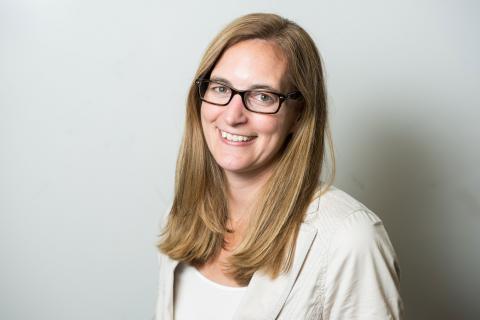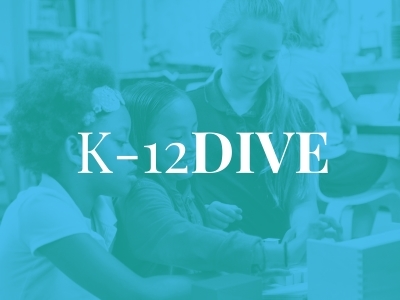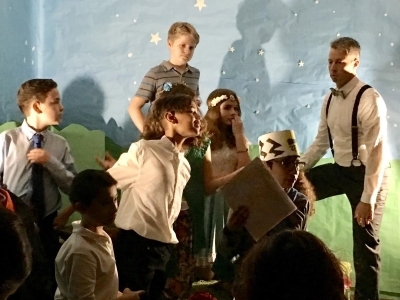Developing Portrait of a Graduate Skills from Elementary School to High School Graduation (and Beyond)
Topics
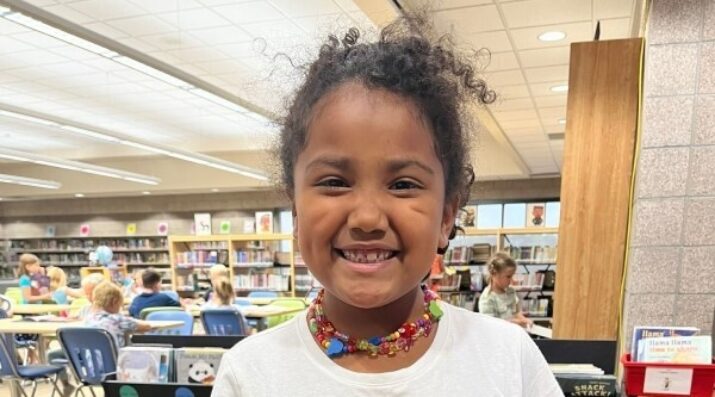
Today’s learners face an uncertain present and a rapidly changing future that demand far different skills and knowledge than were needed in the 20th century. We also know so much more about enabling deep, powerful learning than we ever did before. Our collective future depends on how well young people prepare for the challenges and opportunities of 21st-century life.
These school communities are using their graduate portraits to redesign learning in elementary school and middle school as well as high school.
“If we’re talking about what we want our graduates to have, you can’t get them to that level in just a couple of years. It’s got to start at the very beginning.”
–Daniel Mullins, Principal of Lebanon Junction Elementary School, Bullitt County Public Schools
“Why are we not introducing little kids to these portrait skills that they need? …My whole schooling as a young kid could have been so different if I would’ve found out how I was as a learner and had those skills.”
–Megan Margerum, Third Grade Teacher, Northern Cass School District
“They don’t just arrive at ninth grade and suddenly it’s, ‘Okay, here we go,’ as if you could accomplish this in four years.”
–Laura Dahm, Director of Elementary Education, Kettle Moraine School District
A Portrait of a Graduate identifies the full set of skills and competencies that high school graduates need to thrive in learning, work, and life—like leadership, communication, creative and critical thinking, empowered citizenship, cultural awareness, collaboration, lifelong learning, and problem solving. But as the above quotes from educators demonstrate, a Portrait of a Graduate is a vision for student success that doesn’t start at graduation, or even in high school. We found that the school communities in NGLC’s The Portrait of a Graduate in Practice are using their portraits to rethink elementary school and middle school as well as high school. Northern Cass School District in North Dakota even re-titled its portrait to Portrait of a Learner in recognition that these skills apply to all learners, not just graduates.
As told to us by nearly 50 educators, learners, and community members, these communities are starting in preschool and kindergarten to support the development of graduate portrait skills. And they are creating tools like grade-level indicators, progressions, and instructional look-fors to help.
Preparing Learners for Their Future: “Watch Me Grow”
A finalist for North Dakota’s 2023 Teacher of the Year, third grade teacher Megan Margerum originally thought the Northern Cass Portrait of a Learner was “just for seniors. That’s just for high school kids. I don’t need to worry about that.” But upon reflection of her experience teaching at the elementary level and through conversation with educators in and outside of Northern Cass School District (NCSD), Megan told us that, especially given “all the things kids went through” during the COVID-19 pandemic, she believes even the youngest learners “need these skills now more than ever.”
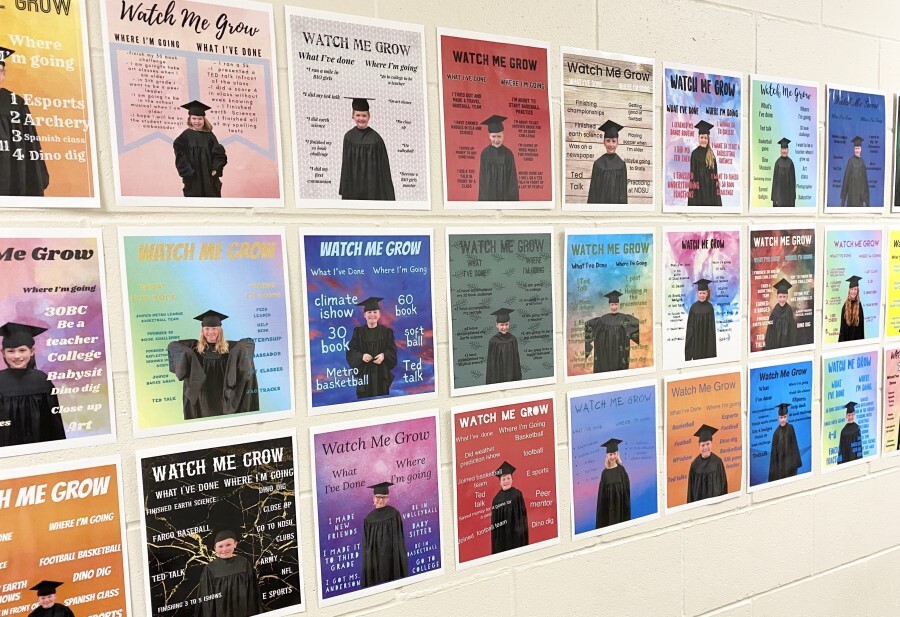
Credit: Megan Margerum, Northern Cass School District
Learners of all ages are supported to envision their futures through the lens of the Portrait of a Learner, as shown in NCSD’s Watch Me Grow project pictured above. One strategy that works across grade levels is focusing on priority standards, a subset of the state’s standards. NCSD educators applied criteria, such as whether a standard is essential for future learning or life, to identify high-leverage standards. As we wrote in NCSD’s Portrait in Practice story, setting priorities creates space for learners “to engage deeply with both content and skills and to demonstrate proficiency in a variety of ways.” Another strategy is making learning transparent and visible, with a “Candyland-style learning pathway on the bulletin board in a lower grade or with a poster with exemplars and specific expectations around performance levels on a high school task.” With these tools, students of all ages know where they are in their learning journey and can track their progress and growth.
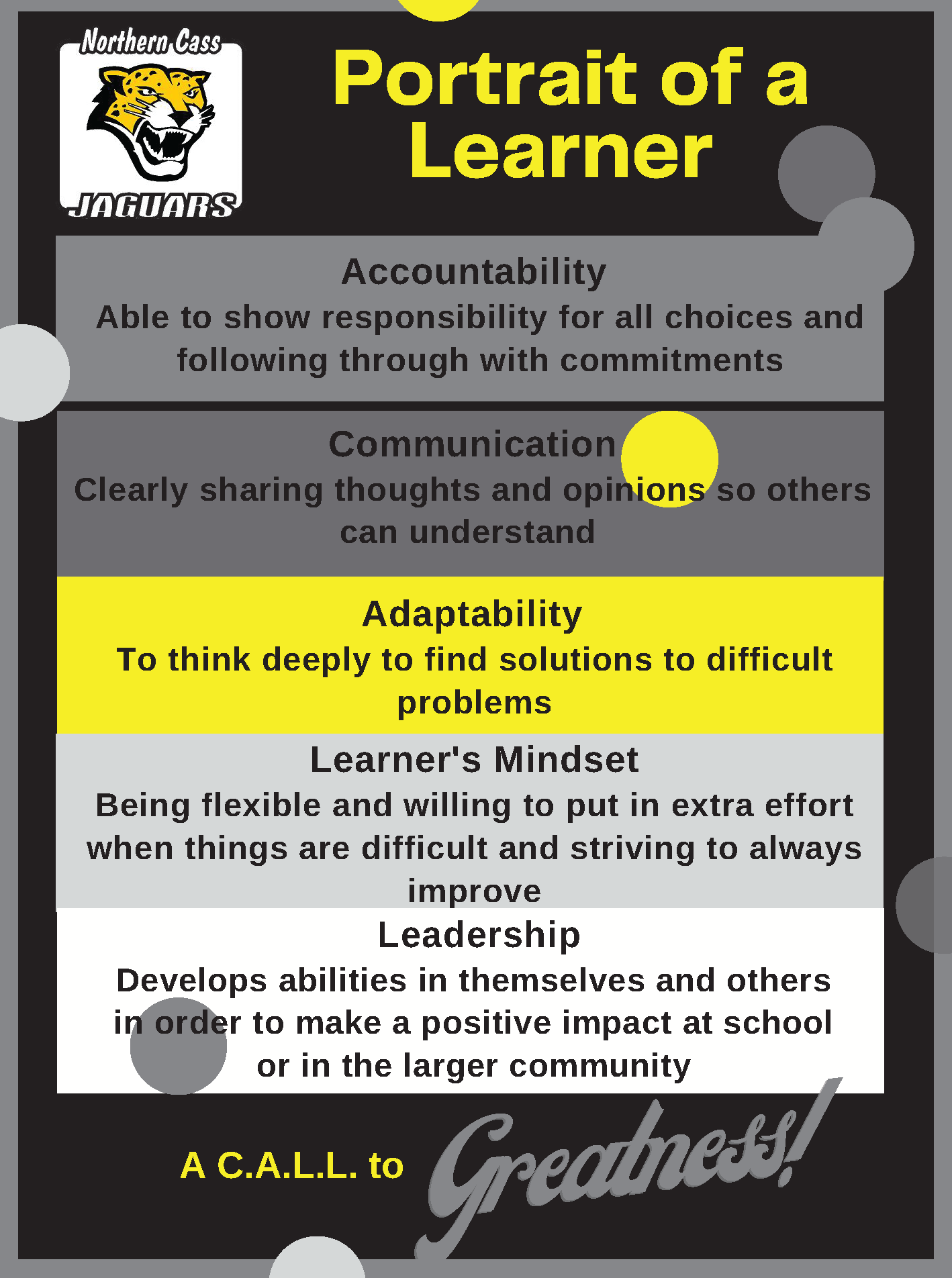
Credit: Northern Cass School District #97
Many schools employ senior capstones as opportunities for students to demonstrate their growth when it comes to graduate portrait competencies, and that’s true at Northern Cass as well. Because the Jaguar Capstone Project has been so successful, the district’s director of personalized learning Tom Klapp told us it has “filtered down to the transition levels—the eighth grade, fifth grade, and third grade. At those levels we call them gateways.” Secondary educator Luke Bush, who co-teaches the year-long eighth grade gateway course with Tom, explained why:
“We know that our transition from eight to nine is big. Even though we’re in the same school, there’s a lot of changes that happen academically and maturity-wise. We go through our Portrait of a Learner skills, we have them reflect on what they are going to need to do to get more prepared for their freshman year, and we design activities and lessons to get learners to engage with those and prepare for their gateway project.”
Different Words, Same Vision of Success
In the Kettle Moraine School District (KMSD) Portrait in Practice story, we reported that “given that the language of the Kettle Moraine Graduate Profile is challenging for children as young as three or four years old to understand and use, educators at Kettle Moraine School District’s (KMSD) elementary schools have embraced the vocabulary of Arthur Costa and Bena Kallick’s Habits of Mind framework.” They focus on the habits that align to their Graduate Profile, with key competencies such as “striving for accuracy, thinking flexibly, managing impulsivity, and being a collaborator, an engaged citizen, and open to continuous learning,” as Laura Dahm, the director of elementary education, explained to us. “They’re all attributes that we really work to bring to light in elementary that help give students vocabulary so that they can see themselves in our Graduate Profile as they grow through our system.”
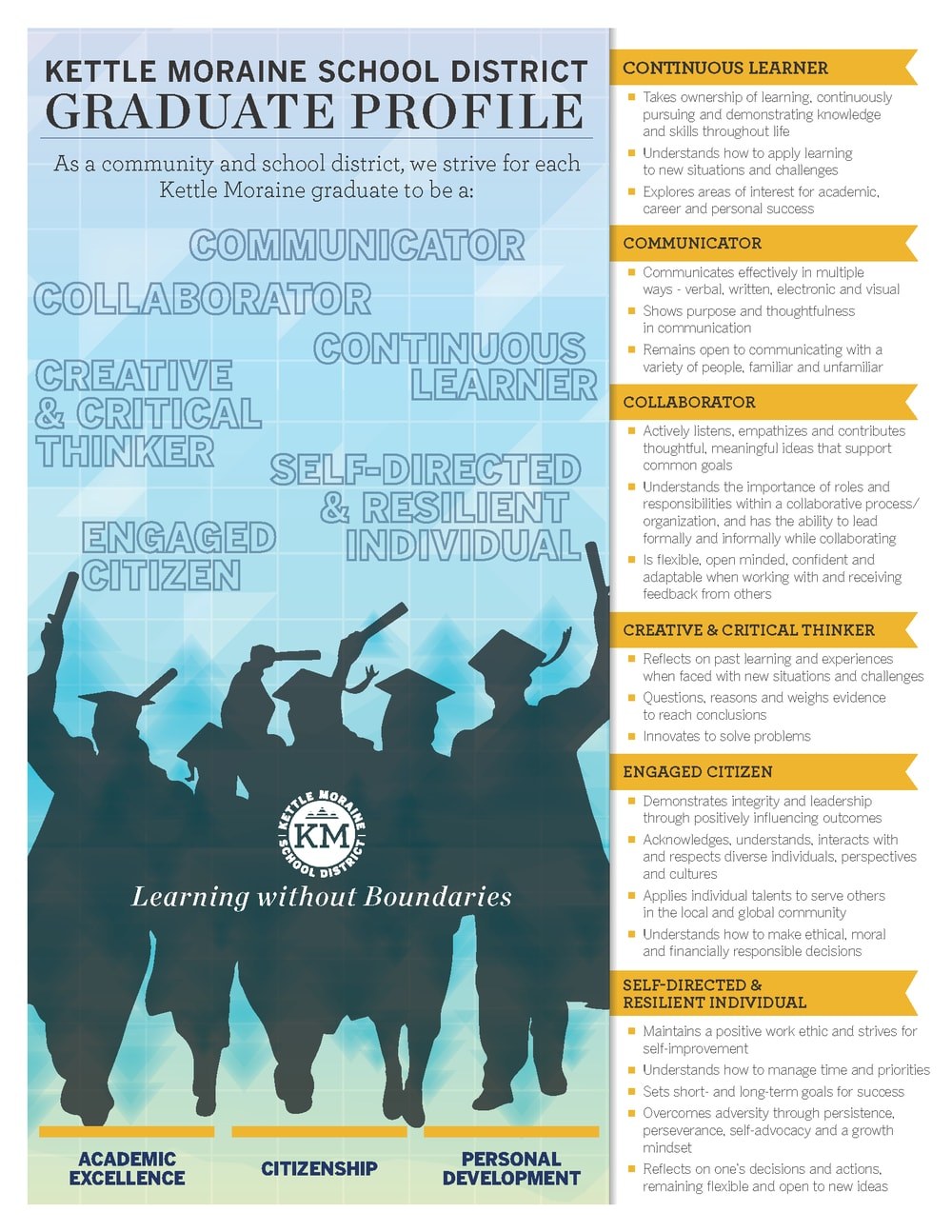
The KM Graduate Profile helps to create a common vision for the district, not just across grade levels but also across a variety of school programs and pathways. To bolster their vision of student success as a unifier and fulfill its purpose of shaping learning across the district, the community began a revisioning process in fall 2021. “The goal was to get K-12 exemplars of what the Graduate Profile actually looked like,” Superintendent Stephen Plum told us. “What does it mean to be a Continuous Learner for a third grader? What does it mean, in terms of look-fors, for the graduate and beyond?”

The result, after a thoroughly collaborative, community-engaged, and iterative process: the Kettle Moraine Graduate Profile Continuum. As described in the document itself, the continuum categorizes “each component of the profile into grade-appropriate skills. Each level establishes agreed upon goals for learning across our schools and environments.” The continuum includes a set of indicators for each component in four grade bands—4K through Grade 2, Grade 3 through Grade 5, Grade 6 through Grade 8, and Grade 9 through Grade 12.
Laura gave us an example of these indicators in practice in the elementary grade bands:
“When teachers are reading Charlotte’s Web as a read-aloud, they might be asking what Habits of Mind Charlotte is displaying or not displaying. You know, students can often find examples in others before they can be reflective enough to find examples in themselves.” Through strategies such as these, she said, Kettle Moraine learners “have eight years of experience building toward the Graduate Profile components before they get to high school.”
Learner Agency Look-Fors
The skills and habits of mind expressed in the seven spheres of Lindsay Unified School District’s (LUSD) Lifelong Learning Standards require active and ongoing cultivation over multiple years.
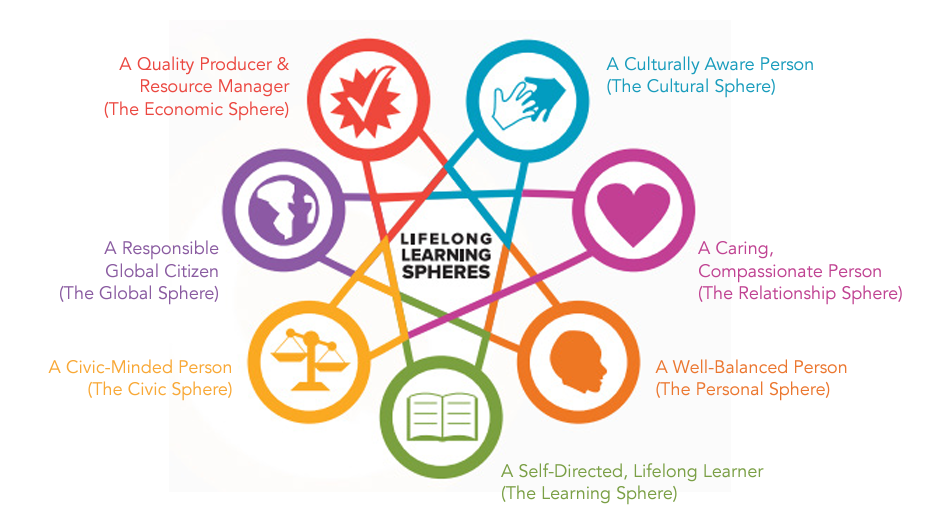
Credit: Lindsay Unified School District
That’s why, Barry Sommer, the development director for the Lindsay Education Foundation, told us, “Every one of these spheres has a very clear set of developmental curriculum, rubrics, and assessments, just like you would for science and math and language arts and and history, that carry from kindergarten all the way through 12th grade. From 5-year-olds to 18-year-olds.” Barry went on to say that learners “can all recite their current SMART goals and talk about lifelong learning goals. That’s part of their vocabulary, part of how they think.”
Here’s a worksheet that kindergarteners use to create personalized short- and long-term SMART goals for literacy.
A coach for elementary teachers (which are known as learning facilitators in Lindsay Unified), Joel Martinez Dominguez told us that young kids have agency to learn that they naturally bring with them to school. He noted that schooling tends to diminish that agency, so it’s essential to foster learner agency in elementary school. Elementary is also a time, he said, to think about the world outside of the classroom to cultivate the mindsets for lifelong learning. As Joel explained to us, this comes from experiential learning in school, and, “especially for our Lifelong Learning Standards, they can show their proficiency at home, in a sport, playing a musical instrument, or in a community outside the education system, like their church. Learning is not just here in the education system; it’s everywhere because that’s part of lifelong learning.”
The LUSD Look Fors Guide is a key resource that learning facilitators across the grade spans use to connect the Lifelong Learning Standards to their approach to teaching and to content standards. As explained in LUSD’s Portrait in Practice story, “The guide presents learner behaviors related to each outcome, videos of teaching practices, a research summary, and other resources, along with suggested actions for learning facilitators, both planned and spontaneous.”
Voice, Choice, and Passion for Learners and Educators
Moving Forward is so central to Kentucky’s Bullitt County Public Schools’ (BCPS) identity that it’s part of the district logo. And they are passionate about moving forward with their Graduate Profile-fueled learning redesign efforts. We found that learners are building graduate profile skills in a developmental approach from elementary through high school. And it doesn’t stop there; the adults in BCPS are using the graduate profile skills to move forward too.
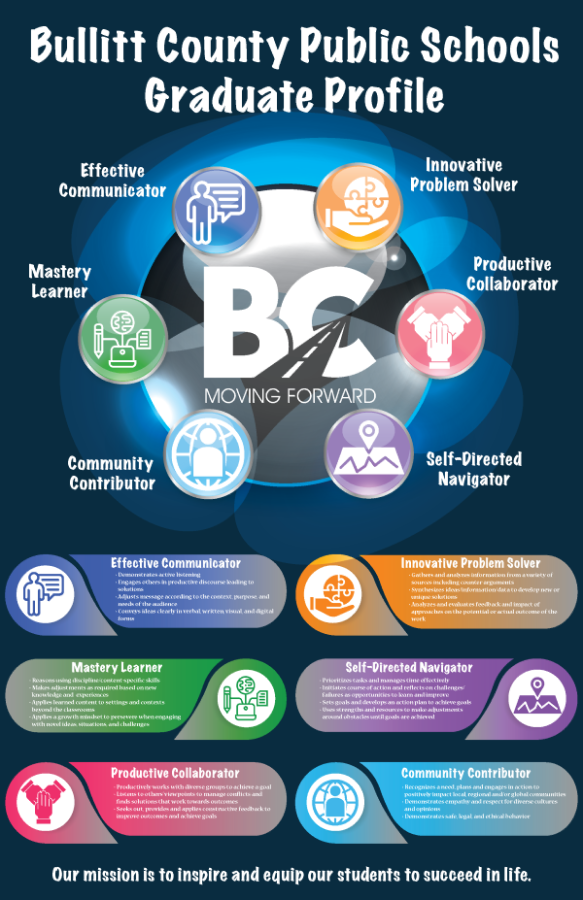
At the elementary school level, for example, principal Daniel Mullins told us how two fifth-grade teachers focused on the BCPS Graduate Profile competency of Self-Directed Navigator: “Kids have a Google survey every day that asks them what their goal for the day is. The kids set it. For some of them it’s a behavior goal. For some of them it’s an academic goal. They’re doing that for the day, but they’re also doing it by lesson. The fifth graders are really internalizing how to self-navigate to set the goals and then navigate to reach them.”
The level of learner voice and choice increases in middle school, where teachers are helping students develop graduate profile skills by intentionally integrating them into lessons. “Any time [the middle school teachers] were doing a group activity,” instructional coach Beau Kaelin explained to us, “they were very explicit about how the students were working on being Effective Communicators and Productive Collaborators and what that means.”
And then in high school, as we learned, Beau and a team of science educators at Bullitt Central High School piloted units where learners are even more directly involved. The quarter-long “passion based” research projects that they piloted are based on learners’ interests, Next Generation Science Standards, and BCPS Graduate Profile competencies. Although scientific processes and problem solving underlie all the projects, Beau told us that students choose their own topics and set personal goals for their learning. Teachers intentionally build in opportunities for learners to develop graduate profile competencies, and they use the district’s Graduate Profile Learning Progression to help learners align their personalized goals to the six competencies.
While the skill-building and growth in learner agency from elementary to high school looks highly scaffolded and prescribed, we learned that this approach was not scripted for teachers. In fact, it has emerged from a learning redesign effort that “builds on strengths, empowers teachers to innovate, and models the kind of professional growth and learning that adults in district schools want their students to experience,” as we wrote in Bullitt’s story. In BCPS, “teachers are leaders, designers, and innovators, not just implementers of change.” We learned that the examples presented here of learning opportunities in elementary, middle, and high school, which embed Graduate Profile competencies, grew out of professional cohorts that BCPS teachers voluntarily elect to join.
Through those cohorts, teachers lead work that they are passionate about. “It’s a professional learning system that gives teachers voice and choice,” said Adrienne Usher, the assistant superintendent, “like we should give our kids.” In other words, learning graduate portrait skills doesn’t start in high school but it doesn’t end in high school either. These skills are essential for all of us.
Learn More about Activating a Portrait of a Graduate
- Teaching Portrait of a Graduate Skills - In this article, find out how teachers are changing their role, mindset, and instructional practices to help their students develop graduate portrait skills.
- Student Work Showcasing Portrait of a Graduate Competencies - This article offers examples of student work that develop and demonstrate graduate portrait skills. See what students do when schools move from portrait to practice.
- The Portrait of a Graduate in Practice - Learn more about the work underway in five school communities as they develop new learning designs focused on a broader, deeper vision for student success. This resource includes five publications and eight short podcasts featuring the voices of educators, learners, and community members. See how each community's unique vision of student success comes to life in their schools.
Photo at top courtesy of Northern Cass School District.

